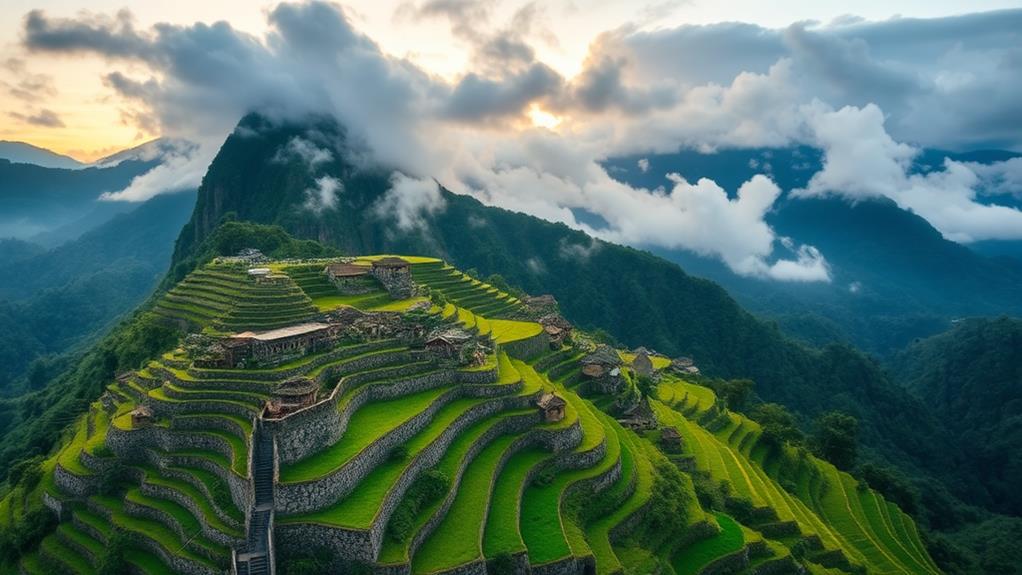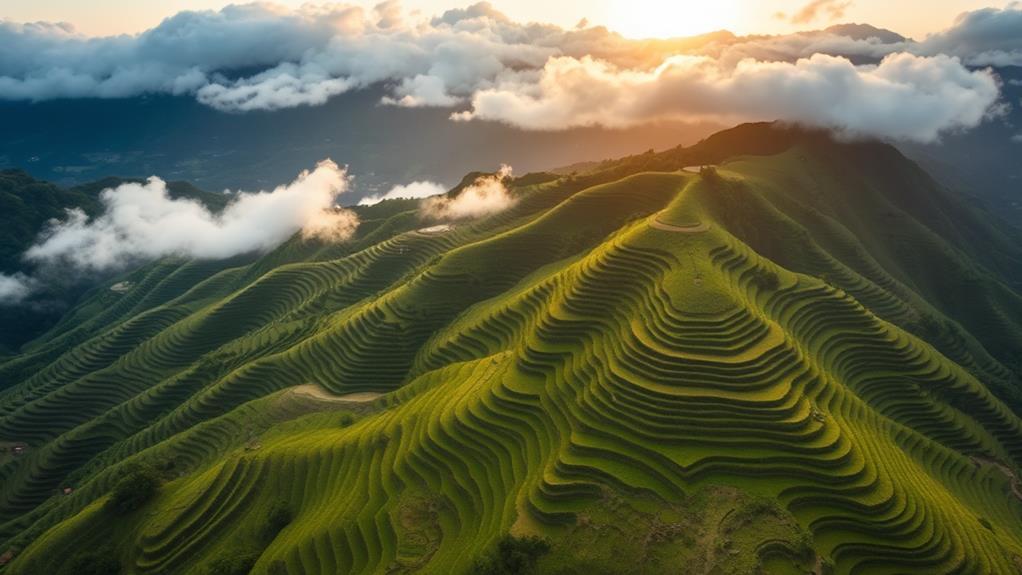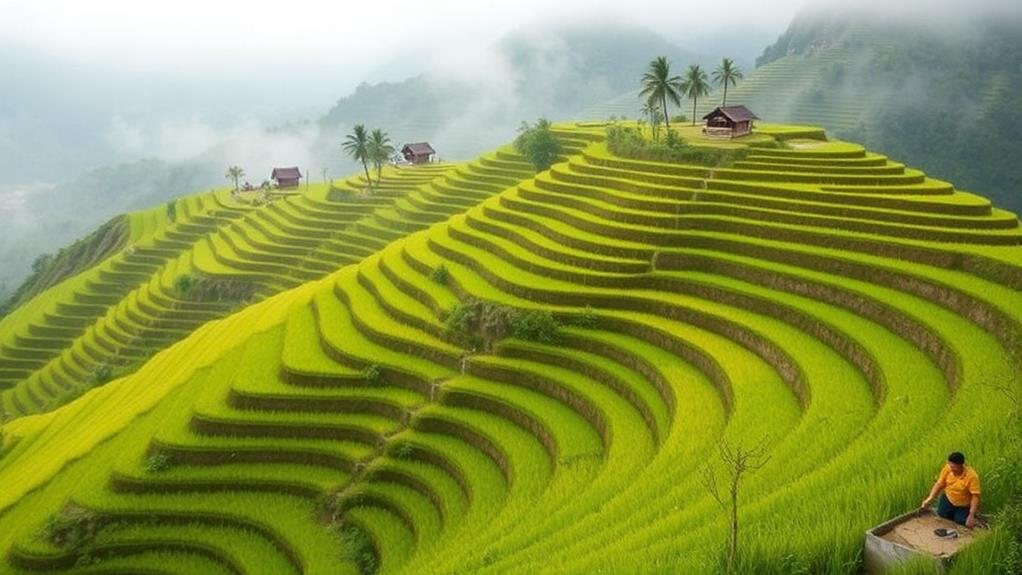The Banaue Rice Terraces: A Testament to Ancient Engineering
The Banaue Rice Terraces are an engineering marvel carved into Luzon's mountains over 2,000 years ago.
This ancient wonder showcases exceptional stonework and irrigation systems, which have supported a sophisticated agricultural practice that has been passed down through generations.
The Terraces: A Cultural Identity
The Banaue Rice Terraces are more than just a beautiful landscape; they're an integral part of the Ifugao people's cultural identity.
The terraces host communal gatherings and festivals that celebrate their heritage, making them a vital part of the community.
Conservation Challenges and Efforts
The preservation of the Banaue Rice Terraces is under threat.
However, conservation efforts are in place to protect this living cultural landscape and its significance.
Explore the challenges and conservation efforts to learn more about the importance of preserving this ancient wonder.
Cultural Significance Unveiled

The Banaue Rice Terraces hold profound cultural significance, deeply intertwined with the daily lives of the Ifugao people. The terraces reflect the social structure and cooperative spirit of the Ifugao community, where traditional farming practices, rooted in indigenous knowledge of irrigation and stonework, highlight the importance of rice cultivation.
For instance, the Ifugao people's expertise in irrigation and stonework is showcased in the intricate network of canals and stone walls that support the terraces.
Agricultural celebrations and thanksgiving feasts during the harvest season bring the community together, reinforcing their connection to the land and ancestral practices. The terraces serve as a venue for communal gatherings, where the Ifugao people celebrate their agricultural heritage and reinforce their cultural identity.
For example, the harvest festival showcases traditional dances, music, and food, strengthening social bonds and cultural continuity.
The Banaue Rice Terraces are a living cultural landscape, where sustainable tourism plays a crucial role in preserving this rich cultural heritage. By supporting local tourism initiatives, visitors can contribute to the preservation of the Ifugao people's cultural identity and traditional practices.
This, in turn, helps to ensure the long-term conservation of the Banaue Rice Terraces for future generations.
Engineering Marvel of the Ancients
The Banaue Rice Terraces: An Engineering Marvel
Construction and Design
The Ifugao people built the Banaue Rice Terraces approximately 2,000 years ago, demonstrating their exceptional engineering skills. The terraces feature intricate stone and mud walls that follow the natural contours of the mountainside, showcasing the Ifugao's mastery of engineering feats.
These walls stretch for 12,500 miles in total length, making them a remarkable achievement.
Irrigation System
The sophisticated irrigation system is a marvel in itself. It sustains rice cultivation by channeling water from nearby rainforests, ensuring a consistent water supply for the crops. This system is a testament to the Ifugao people's understanding of their environment and their ability to work with nature.
Scale and Community Effort
The sheer scale of the project is astonishing. If laid end to end, the terraces could encircle half of the globe, highlighting their monumental scale and the ingenuity of their construction.
The maintenance and operation of the terraces required intensive community cooperation, reflecting the social structure and communal values of the Ifugao people.
Preserving a Living Cultural Landscape

The Banaue Rice Terraces embody the Ifugao people's enduring legacy, requiring a delicate balance between cultural heritage and modern-day sustainability. This National Cultural Treasure has been continuously managed by the Ifugao people for over 2,000 years.
The five distinct clusters of terraces – Nagacadan, Hungduan, Mayoyao, Bangaan, and Batad – showcase unique architectural designs and traditional village life, highlighting the region's cultural diversity.
The Ifugao Terraces Commission implements conservation efforts to ensure the sustainable use of ancestral lands and protect local traditions.
Ongoing restoration programs focus on physical rehabilitation and reviving cultural practices, essential for maintaining the authenticity and integrity of this living landscape.
By preserving the Ifugao rice terraces, you're helping to safeguard a cultural landscape of unparalleled importance, where traditional agricultural practices and community cooperation continue to thrive.
Challenges and Conservation Efforts
The Banaue Rice Terraces face significant challenges that threaten their existence. These challenges include climate change, rural-to-urban migration, and neglect, which led to the terraces being listed as a World Heritage in Danger from 2001 to 2012.
Today, approximately 25-30% of the terraces are abandoned, resulting in the deterioration of irrigation systems and agricultural practices.
To address these challenges, conservation efforts are underway. Local government and NGOs are collaborating on restoration initiatives that focus on community engagement for effective conservation and maintenance.
Sustainable tourism programs have been introduced to revitalize the local economy while supporting conservation efforts. The Comprehensive Rice Terraces Master Plan has been established to address management and socio-economic challenges, emphasizing the need for continuous conservation and protection measures.
Experiencing the Banaue Rice Terraces

As you step into the majestic Banaue Rice Terraces, you're immediately immersed in a world of breathtaking vistas and rich cultural heritage.
The terraces have long been a cornerstone of Ifugao Province's agricultural practices, passed down from generation to generation.
To experience the terraces fully, engage in hiking adventures around the terraces, offering stunning panoramic views of the meticulously carved landscapes while experiencing the local environment.
For example, hike to the viewpoint at Ducligan, which offers a breathtaking view of the entire terraces.
To delve deeper into the culture, take a guided tour to gain insights into the rich cultural heritage and agricultural practices of the Ifugao people.
This will provide a better understanding of the labor-intensive process that has preserved this cultural heritage site for centuries.
To relax and take in the scenery, picnic at one of the many spots along the emerald hillsides, with the terraces as a stunning backdrop.
This allows you to appreciate the careful harvesting of water and the beautiful landscape.
The Banaue Rice Terraces offer something for everyone, whether you're a photography enthusiast, an adventure-seeker, or simply looking to connect with nature and culture.
Frequently Asked Questions
Is Banaue Rice Terraces Man-Made or Man-Made?
The Banaue Rice Terraces are man-made.
The Ifugao people's ingenuity in rice cultivation led to the development of indigenous terracing methods, showcasing their advanced understanding of agricultural practices.
This ancient wonder was created by the Ifugao people, who carved the terraces into the mountainsides over 2,000 years ago.
Was Banaue Rice Terraces a Wonder of the World?
The Banaue Rice Terraces aren't officially one of the traditional Seven Wonders of the World. However, they're often referred to as the "Eighth Wonder" due to their breathtaking beauty and historical significance.
The Banaue Rice Terraces are an ancient agricultural marvel that showcases the Ifugao people's sophisticated rice cultivation practices.
These practices highlight their cultural heritage and sustainable farming methods. For example, the terraces are carved into the mountainsides, allowing the Ifugao people to farm in a challenging terrain.
UNESCO has recognized the importance of the Banaue Rice Terraces. They've been designated as a World Heritage Site, underscoring their cultural and historical significance.
Conservation efforts have been put in place to preserve this valuable cultural asset for future generations.
What Is Special About Banaue Rice Terraces?
Banaue Rice Terraces' uniqueness stems from their blend of ancient history, cultural heritage, and sustainable farming practices.
These agricultural marvels have been perfected over centuries, showcasing innovative techniques that offer breathtaking views and a glimpse into local traditions. For instance, the terraces' steep slopes are built into the mountainside, allowing farmers to cultivate rice, vegetables, and fruits in a challenging landscape.
This ancient engineering feat demonstrates the ingenuity and resourcefulness of the Ifugao people, who developed a self-sustaining system that has endured for over 2,000 years.
As a tourist attraction, the Banaue Rice Terraces contribute to community development while minimizing environmental impact.
The terraces' popularity supports local livelihoods, as tourists engage with the community and support small-scale enterprises.
At the same time, sustainable farming practices ensure the preservation of the environment, maintaining the delicate balance between agriculture and ecology.
This harmonious relationship between humans and nature is a testament to the Ifugao people's deep understanding of their ecosystem.
What Is the Issue With Banaue Rice Terraces?
The Banaue Rice Terraces face significant threats to their existence. Terrace erosion is a major issue, exacerbated by poor water management and climate impact. For instance, when heavy rainfall occurs, the lack of proper irrigation systems causes water to accumulate, leading to soil erosion and damaging the terraces.
Another challenge is the shift towards tourism, which compromises cultural preservation and agricultural sustainability. The local community's focus on tourism has led to a decline in traditional farming practices, threatening the very existence of the terraces. For example, many farmers are abandoning their traditional roles to work in the tourism industry, resulting in a loss of knowledge and skills necessary to maintain the terraces.
The historical significance of the Banaue Rice Terraces is at risk due to these interconnected problems. If left unaddressed, these issues will continue to threaten the terraces' existence, compromising their cultural and historical value for future generations.